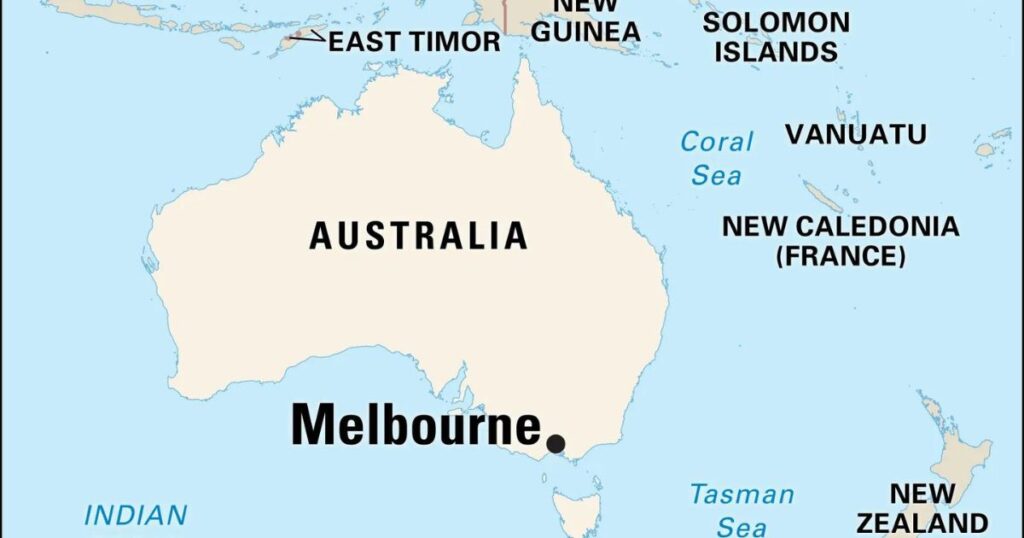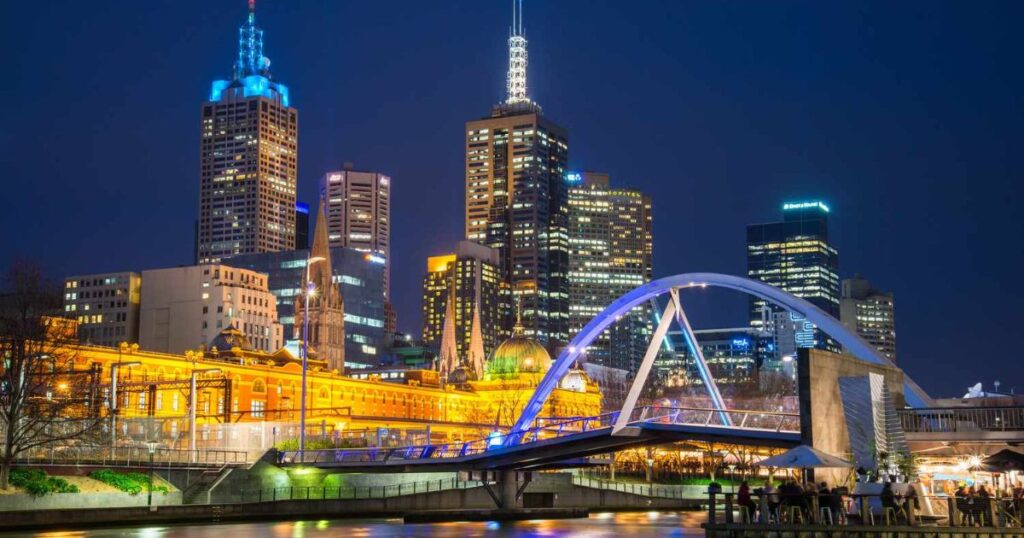Melbourne, the capital city of the Australian state of Victoria, is a vibrant metropolis known for its rich history, cultural diversity, and significant geographic importance. Situated at the head of Port Phillip Bay, Melbourne is the second-most populous city in Australia. The city boasts a unique blend of modern and Victorian architecture, bustling laneways, world-class dining, and a thriving arts scene, making it a popular destination for tourists and a desirable place to live.

History of Melbourne
Early Settlement and Founding
Melbourne’s history dates back to the early 19th century when European settlers first arrived in the area. The city was founded in 1835 by a group of free settlers from Van Diemen’s Land (now Tasmania), led by John Batman and John Pascoe Fawkner. They established the first permanent settlement on the banks of the Yarra River. The settlement was named Melbourne in 1837 in honor of the British Prime Minister, William Lamb, 2nd Viscount Melbourne.
Gold Rush Era
The discovery of gold in Victoria in the 1850s transformed Melbourne into a bustling epicenter of activity. The gold rush attracted people from all over the world, leading to rapid population growth and economic development. By the late 1850s, Melbourne had become one of the wealthiest cities in the world. The wealth generated from the gold rush funded the construction of grand public buildings, parks, and institutions, many of which still stand today. The iconic Royal Exhibition Building, built in 1880, is a testament to this period of prosperity and remains a UNESCO World Heritage site.
20th Century to Present
Throughout the 20th century, Melbourne continued to grow and evolve. It became a major industrial and commercial center, playing a crucial role in Australia’s economy. The city’s cultural landscape also flourished, with the establishment of numerous galleries, theaters, and museums. In recent decades, Melbourne has been recognized for its high quality of life, multicultural population, and dynamic arts and music scenes. Today, it stands as a global city with a thriving economy and a reputation for innovation and creativity.
Geographic Importance
Location and Climate
Melbourne is strategically located at the southeastern tip of mainland Australia. Its proximity to the coast and the presence of the Yarra River contribute to its temperate oceanic climate. The city experiences four distinct seasons, with mild winters and warm summers. This favorable climate makes Melbourne an attractive destination for both residents and tourists. The city’s coastal location also provides access to beautiful beaches and scenic coastal drives, such as the Great Ocean Road, which is renowned for its stunning views and natural landmarks like the Twelve Apostles.

Urban Layout and Architecture
Melbourne’s urban layout is a testament to its rich history and modern development. The city center, known as the Central Business District (CBD), is characterized by a grid-like street pattern and a mix of Victorian-era buildings and contemporary skyscrapers. Notable landmarks include the Royal Exhibition Building, Flinders Street Station, and Federation Square. The city is also known for its extensive network of parks and gardens, including the Royal Botanic Gardens and Fitzroy Gardens, which offer residents and visitors green spaces for relaxation and recreation.
Transport and Connectivity
Melbourne boasts an extensive public transportation network, including trams, trains, and buses, making it one of the most accessible cities in Australia. The iconic Melbourne tram network is the largest in the world, offering convenient travel options within the city. Additionally, Melbourne Airport connects the city to major international and domestic destinations, enhancing its global connectivity. The city’s well-planned road infrastructure and bicycle-friendly streets further contribute to its reputation as a livable and accessible metropolis.
Cultural Significance and Attractions
Arts and Entertainment
Melbourne is often referred to as the cultural capital of Australia, and for good reason. The city is home to numerous art galleries, theaters, and live music venues. The National Gallery of Victoria, the Melbourne Theatre Company, and the Melbourne Symphony Orchestra are just a few examples of the city’s rich cultural offerings. The annual Melbourne International Arts Festival and the Melbourne International Comedy Festival attract visitors from around the globe. Additionally, Melbourne’s street art scene, particularly in areas like Hosier Lane, has gained international acclaim for its creativity and vibrancy.
Sports and Recreation
Sport is an integral part of Melbourne’s identity. The city hosts several major sporting events, including the Australian Open (tennis), the Melbourne Cup (horse racing), and the Formula 1 Australian Grand Prix. Melbourne is also home to the Melbourne Cricket Ground (MCG), one of the largest stadiums in the world, and a hub for cricket and Australian rules football. The city’s passion for sports extends to local clubs and community sports, with numerous facilities and parks dedicated to various athletic activities.
Dining and Nightlife
Melbourne’s culinary scene is renowned for its diversity and quality. The city boasts a plethora of dining options, from high-end restaurants to eclectic street food. Melbourne’s laneways are famous for their hidden bars and cafes, offering unique and intimate dining experiences. The vibrant nightlife scene includes everything from chic rooftop bars to lively nightclubs. Notable dining precincts such as Lygon Street, known for its Italian cuisine, and Chinatown, with its array of Asian restaurants, reflect Melbourne’s multicultural influences.

Melbourne’s Economic Landscape
Key Industries
Melbourne’s economy is diverse and robust, with key industries including finance, technology, manufacturing, education, and healthcare. The city is home to the headquarters of numerous multinational corporations and financial institutions. The Melbourne Biomedical Precinct is a leading center for medical research and innovation. The city’s commitment to sustainability and green technology is also evident in initiatives aimed at reducing carbon emissions and promoting renewable energy.
Business and Innovation
Melbourne is a hub for innovation and entrepreneurship. The city fosters a thriving startup ecosystem, supported by numerous incubators, accelerators, and co-working spaces. Melbourne’s universities and research institutions collaborate closely with industry, driving advancements in various fields, from biotechnology to information technology. Events like the Melbourne Startup Week and the presence of innovation districts, such as the Melbourne Innovation Districts, underscore the city’s role as a leader in fostering creativity and business growth.
Living in Melbourne
Education and Healthcare
Melbourne is renowned for its high-quality education and healthcare systems. The city is home to several prestigious universities, including the University of Melbourne and Monash University, which attract students from around the world. Melbourne’s healthcare system is equally impressive, with world-class hospitals and medical facilities providing top-notch care. The Royal Melbourne Hospital and the Peter MacCallum Cancer Centre are among the leading medical institutions in the country.
Real Estate and Living Costs
The cost of living in Melbourne varies depending on the suburb, with the inner city being more expensive than the outer suburbs. Despite this, Melbourne consistently ranks as one of the most livable cities globally, thanks to its excellent infrastructure, green spaces, and community amenities. The real estate market offers a wide range of options, from modern apartments to charming Victorian houses. Suburbs like South Yarra and Fitzroy are popular for their vibrant lifestyles, while areas like Kew and Malvern are known for their family-friendly environments and prestigious schools.
Community and Lifestyle
Melbourne is a multicultural city with a vibrant and inclusive community. Residents enjoy a high quality of life, with access to numerous parks, recreational facilities, and cultural events. The city’s diverse population brings a rich tapestry of cultures, cuisines, and traditions, making Melbourne a truly global city. Festivals celebrating various cultural heritages, such as the Chinese New Year and the Greek Festival, are regular features of Melbourne’s social calendar, highlighting the city’s commitment to inclusivity and diversity.
Conclusion
Melbourne is a city that seamlessly blends history, culture, and modernity. Its geographic importance, coupled with a rich cultural heritage and a strong economic foundation, makes it a standout destination in Australia. Whether you’re a resident or a visitor, Melbourne offers a unique and enriching experience that is hard to find elsewhere. From its historic landmarks and cultural institutions to its vibrant neighborhoods and thriving economy, Melbourne stands out as a city of opportunity and endless possibilities.
Read more at abbottours.com
